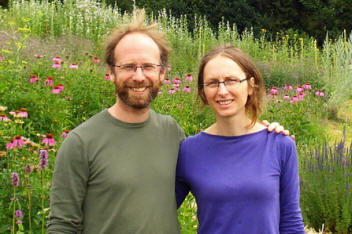|
Folk Method:
There is a European folk tradition of making salves and ointments using butter that we prefer to replace with ghee for better results. This method uses fresh herbs. First, heat ghee in an enameled pot to a liquid and then stir in the finely chopped herb. Simmer gently for 30 minutes and then remove the pot from the heat source, cover and leave overnight. The following day again warm the mixture to a liquid and strain into another container. Add Agnihotra ash powder, and pour the medicated ghee into suitable jars.
You can make medicated ghee with many different herbs like, Comfrey, Thyme, and Yarrow, for example.
A teaspoon 1-2 times a day can also be used internally, depending on the herb used.
Calendula Medicated Ghee is an excellent remedy for all kinds of cuts, scrapes, bruises, and minor burns, including sunburn. It can also be used for dry skin conditions such as eczema and psoriasis. Use Calendula if you suspect scarring, even old scars can improve with this ointment.
A Calendula infusion soothes stomach ulcers and inflamed digestive systems. It aids digestion and gall bladder problems. It is also taken as an infusion to help regulate menstruation and ease painful periods.
For infusions use 2 teaspoons of dried flower petals and a pinch of Agnihotra ash per cup of boiling water. Let steep for 10-15 minutes. |
Internally as an infusion, and externally as a wash or ointment, it can help with fungal infections.
A cooled Calendula infusion makes a useful wash or compress for eye infections.
Calendula brings joy to the garden and as you can see, it has many medicinal uses. But the petals are also edible and they make a colourful addition to salads and can be used as an alternative to Saffron when cooking rice. |

